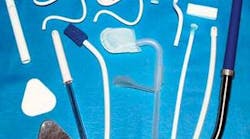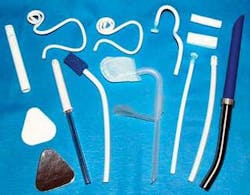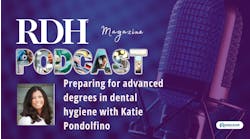There is a marvelous exhibit at the Samuel D. Harris Museum of Dentistry in Baltimore, Md., called “Saliva: The Magic Fluid.” While it is geared to young adults, dental professionals find saliva facts fascinating as well. We know saliva is a precious fluid that aids in digestion, is critical to patient comfort, assists in remineralization, and impacts one’s sense of taste.
As much as we appreciate saliva, there are times when too much moisture can create problems in the clinical setting. Most clinicians use power-driven scalers on a routine basis. These and a patient’s natural moisture create evacuation and visual acuity challenges.
While most pit and fissure sealant applications require moisture control, other procedures performed by hygienists need moisture control management systems as well. It would be impossible to use a power scaler without an evacuation system. This can also be important when using hand instruments, applying certain types of medicaments, or placing some restorative materials.
Fluid or moisture management systems were limited decades ago. They included conventional saliva ejectors, high-volume suction devices, surgical aspiration tips, and cotton gauze squares and cotton rolls, used with or without various types of retention devices. While these devices worked well, there was definite need for improvement.
The effectiveness of saliva ejectors
The lowly saliva ejector is one of the first things a dental hygienist works with in the clinical setting. Traditional models are plastic. A flexible wire runs through the length of the device, which allows the user to create a hook-like end to fit into the mouth. Adding a second bend about an inch below the common candy cane bend creates a suction device that stays in an out-of-the way position where it can efficiently remove fluid, yet not interfere with the clinician’s work space.
The flexibility of a saliva ejector is based on the type of plastic. Brand name products are made with virgin plastic compounds that produce a consistently flexible product with every batch. House brands may be made with recycled plastic components, which can result in products that are not easy to bend.
Patients often feel that the hard plastic end of the saliva ejector is uncomfortable. Slipping a specially designed sponge onto the hard end can alleviate this problem. This not only cushions the device but also improves the aerosol capturing abilities. The Otis Formajet saliva ejector is fabricated with a small latex sponge glued to the tip. Both of these solutions increase patient comfort and reduce the possibility of bruising fragile soft tissues in the vestibule or floor of the mouth. In addition, a padded saliva ejector can do double duty as a cheek retractor.
Two other types of saliva ejector designs create a hands-free approach to managing fluid evacuation. Hygoformic devices have a series of small holes that perforate a flat coil that can be bent to fit in the floor of the mouth, behind the retromolar pad, or in the vestibule. Clinicians can stabilize this device by using various custom bends to fit individual patients.
There are disposable as well as autoclavable devices that not only provide fluid evacuation, but also contain a small, flat restraint to place between the patient’s tongue and teeth to form a barrier that keeps a wiggly tongue under control. Some of these devices are secured with an under-the-chin pad, and while successful, they can be uncomfortable if a patient has lingual tori.
There are mirrors with hollow handles that can be hooked up to slow-speed saliva ejectors. Fluid enters tiny holes around the edge or on the side of the mirror, and travels through the handle to the conventional saliva ejector hose. Some mirror suction devices are fully autoclavable and others work with a single-use disposable mirror.
While these combination devices sound like the perfect solution to visual acuity, there are some special considerations. The mirror must be held in position to capture the fluid, and this is not always practical. One must also consider the overall weight of the device, which includes the weight and torque of the saliva ejector hose.
The size and number of holes in any device determine its effectiveness in the clinical setting. For example, both the Hygoformic and Otis Formajet saliva ejectors have small holes, which are perfect for routine patients, but they clog up quickly when a patient presents with wall-to-wall deposits. In this case, a saliva ejector with a slip-on sponge will function effectively for a longer period of time.
Suction devices
High-volume evacuation (HVE) devices are best in an assisted clinical setting due to the length, overall weight, and torque of the apparatus and hose. Young Dental’s RotoVac has a 360-degree rotating swivel and an autoclavable blue neoprene sleeve that pads the length of the device. Clinicians who prefer to use high volume can shorten the plastic HVE tube, which creates a more balanced device for the unassisted clinician.
Suction hoses should be of sufficient length, lightweight, and supple. Replacing them is inexpensive and can be done in about five minutes. Turn the vacuum pump off, and immerse both ends of the new hose in very hot water for a few minutes to improve hose flexibility and facilitate installation. This is a perfect time to replace the on/off control with an ergonomic flip switch as opposed to a rotating knob.
The Isolite suction system is a hybrid device that controls moisture, acts as a mouth prop, and provides intraoral illumination. It is the perfect device for an unassisted clinician who wants to focus on quadrant treatment without skipping a beat.
The basics of moisture control
Now back to the basics. A variety of disposable products can help control moisture. Cotton rolls, gauze, and absorbent wafers have been around for years, but like many products, new materials are improving efficiency and increasing patient comfort.
Years ago cotton rolls and gauze were fabricated with real cotton fibers and fillers. Today’s material scientists have created super-absorbent substances that can soak up many times their weight in fluid. Today’s typical gauze is made from soft synthetic fibers that absorb fluid, don’t tear easily, and don’t shed annoying fiber wisps.
Traditional cotton rolls absorb moisture but can be uncomfortable, rigid, difficult to remove, and need frequent replacement. Clinical frustration with cotton rolls led to the creation of a super absorbent, soft substitute called P.A.D.S. These can be cut to fit small, tight areas. It is now possible to complete an entire quadrant of sealants with one set.
There are also flat wafers that absorb parotid gland salivary flow. It is easy to place this moisture magnet over the duct at the beginning of a procedure. In addition, foil-covered pads reflect more light in the oral cavity, which improves visual acuity. A quick spray of water will help loosen a stubborn cotton roll or absorbent pad at the end of a procedure.
There is no one fluid control device that will work well for every clinical situation, and there are techniques that require more than one product or device. Tasks become more complex when a clinician works without a chairside assistant.
Placing a traditional acid etch sealant is a perfect example. To keep the field dry, an unassisted clinician could use a variety of products. A combination of a saliva ejector, cotton rolls, and an absorbent pad placed over the parotid gland work well for sealing a maxillary tooth. A saliva ejector with a lingual restraint keeps the tongue away from an etched surface on the mandibular arch. Some clinicians prefer high-volume suction for sealants to keep the teeth, cotton rolls, and parotid blockers dry.
In addition to suction devices and moisture control products, it is important to use a chemical drying agent after the etch/rinse in the hydrophobic resin sealant procedure. Resin sealants are hydrophobic in nature. The slightest bit of moisture can interfere with proper attachment of the sealant material to the etched surface.
Managing moisture effectively is a challenge that every clinician faces. A rising tide of thick, ropy saliva or a patient sputtering over the power scaler fluid can quickly ruin your comfort zone.
It’s easy to order these products from your favorite dental supply company. Why not add some new products or tricks to your clinical repertoire?
Anne Nugent Guignon, RDH, MPH, is the senior consulting editor for RDH magazine. She is an international speaker who has published numerous articles and authored several textbook chapters. Her popular programs include ergonomics, patient comfort, burnout, and advanced diagnostics and therapeutics. Recipient of the 2004 Mentor of the Year Award, Anne is an ADHA member and has practiced clinical dental hygiene in Houston, Texas, since 1971. You can reach her at [email protected] or (713) 974-4540, and her Web site is www.anneguignon.com.
How do you decide on which fluid evacuation or moisture control system to use? Consider these qualities ...







